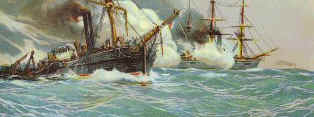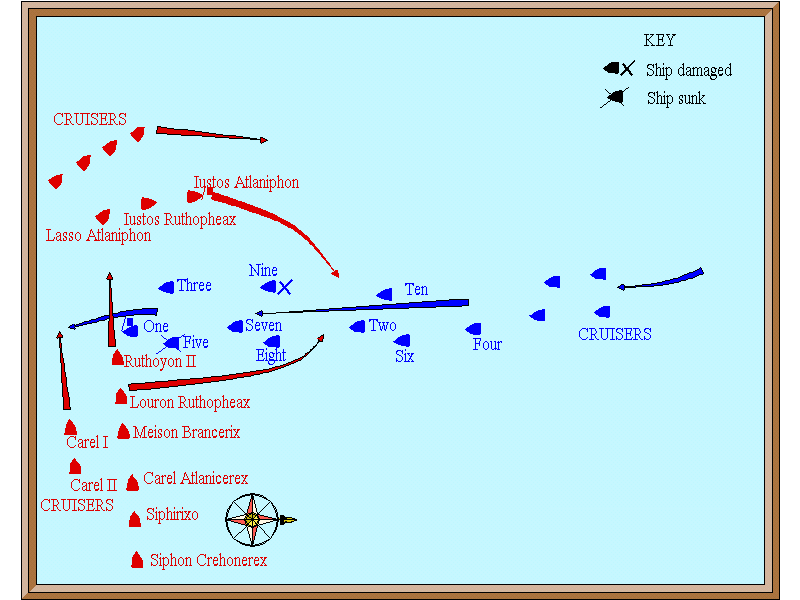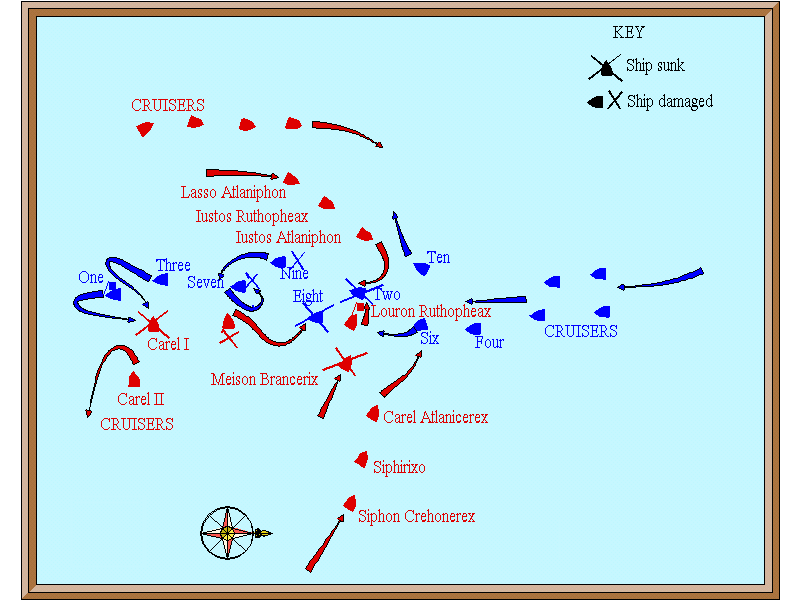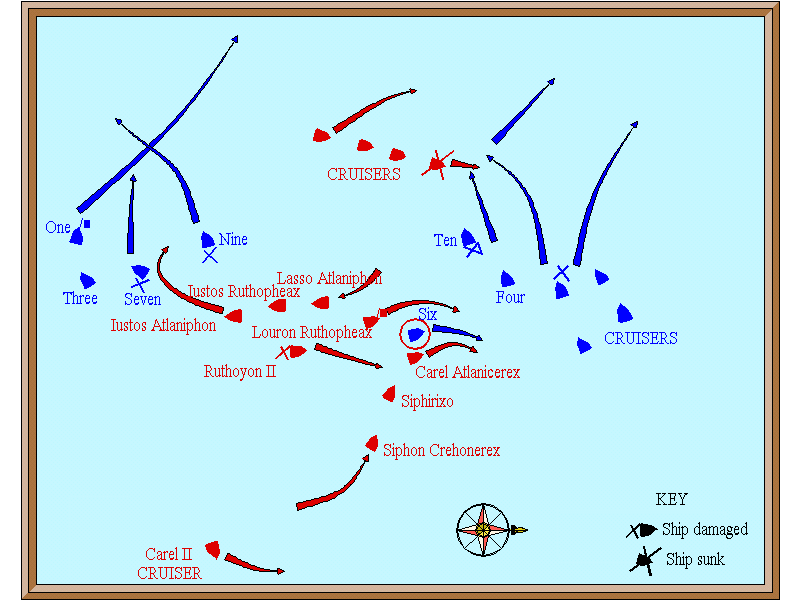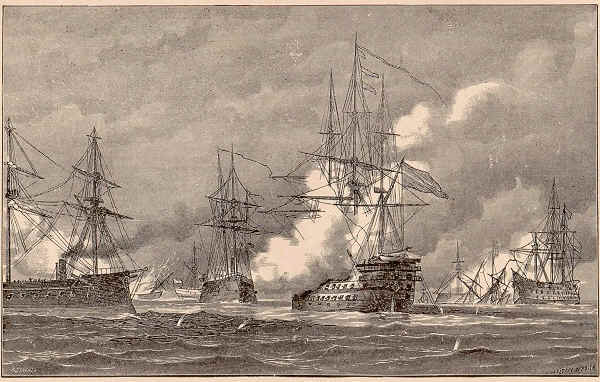|
Home Page
Discovery of Atlantis
First Empire-(1) to 261
Second Empire- (1) 361 - 409 |
|||||||||||||||||||||||||||||||||||||||||||||||||||||||||||||||||||||||||||||||||||||||||||||||||||||||||||||||||||
THE NAVY DURING THE FIRST AND SECOND EMPIRES TILL 585 The first naval base of the nascent Atlantean Empire was on eastern side of the Atlano Mandengio, the island opposite the city of Atlantis. This situation provided a sheltered and protected port and harbour from the earliest days. In the first half of the third century, this navy consisted of high-boarded sailing-ships little different from those used by merchants in their trading activities. Many also had oars for inshore manoeuvering. Atlantis' first major naval conflict was with the Phonerians, in the First War of 241 - 245. In this war the Atlanteans were seriously outmanoeuvered by the faster largely oared Phonerian ships, which could also ram. But these ships were generally too low to be able to board the higher Atlantean ships. A few years later, the war with the Helvrans began. The naval side of this conflict was of vital importance to both sides, and here Atlantis came up against a very large force of oared galleys, developed by the Helvrans for use in the relatively sheltered Helvengio. These defeated the Atlanteans in the initial battles, as the latter's sailing-ships were unable to corner the galleys. Atlantis learned from this and built larger sail and oared galleys as well as some bigger ships operated purely by sail. With these developments and superior tactics, the Atlanteans eventually gained command of the seas. Tactics remained the use of bows and arrows and ramming and boarding enemy ships. After this time, and especially in the fourth century, fire-power on ships developed considerably, with the use of mechanical artillery (crossbows, catapults and ballistae) and fire projectiles. About 270, after the conquest of Helvrieh and Manralia and the seizure of the main bases of the Helvran navy at Giezuat and Noehtens, a small naval force was established in the Helvengio, based at Giezuat and initially using captured Helvran ships. In 318 there took place the Second War with the Phonerians. This time Atlantis used much larger sail and pared ships, now with some basic artillery on board. The Phonerians had also developed similar ships, but they were overwhelmed by the quantity and quality of the Atlantean force. The Phonerian navy had been based at Achosil and on other islands in the bay of Marossan. After the defeat of the Phonerians, Atlantis set up a third naval base at Achosil. Finally in 370 a fourth base was added, initially at Meisting in Th. Thiss. This was moved south to the new colony of Siphiya around 500. These bases remained throughout the Second Empire, supplemented by smaller administrative and supply stations elsewhere, such as at Noehtens, Phaioso, Nosinge and later on Phonaria and Trayanaxo, as well as the mid-channel fortress island of Pand-engeyu. The Atlantean navy had relatively few combative tasks during the period of the Second Empire: their main task was to protect trade against raiders and pirates. In the Civil War of 524-526, there was some fighting between the rebel Giezuat navy and the loyalist Atlantean one, which led to the rebelling of the Atlantean force as well. Other forces remained inactive. There was also some sparring between Atlantis and the new Basquec forces around 500 - 510 in the south and again in the bigger war after 582. There were no important developments or changes to the ships at all during all this time, other than the increase and improvement of shipboards mechanical artillery and the gradual abandonment of oars in favour of sailing-ships. Galleys were rarely used by any of the great naval powers, but the Atlanteans, Basquecs and Eliossiens retained them for inshore work, amongst islands and on rivers. THE REVOLUTION AND WARS OF THE PRETENDERS, 585 - 650 In the Revolutionary period, nearly all the naval forces of Atlantis went over to the Revolutionaries, with the exception of some ships in Phonaria, which were soon overcome, and the fleet based at Siphiya. Apart from skirmishes with the other Republican fleets, this loyalist navy remained in control of the Southern Channel in the 580s and early 590s. After that it was involved in a series of attacks by the Basquec navy which inflicted heavy losses and forced it back into harbour. The Atlantean southern colonies were hereafter cut off from all outside contact and supply until the 630s, other than via the difficult cross-desert journey through partially hostile territory to Yall. Thiss. During the period 600 - 620, Basquec naval raids penetrated right up the western coast of Th.Thiss. at times. After the fall of Atlantis city to the Imperialists, the Atlantis based navy reverted to Imperialist (Ruthopheax's) control very quickly. However the fleet based in Yciel Atlantis remained true to the Republicans for a while and protected that province to which many Revolutionaries had fled. Later an Imperialist amphibious expedition from Phonaria and Atlantis reconquered Yciel Atlantis and defeated the republican navy. The Giezuat navy had joined the Imperialist faction of Group "A", and only came under Ruthopheax's control after his defeat of that power in 647. The main change in armament was the introduction of gunpowder artillery on board after the 620s, chiefly in the Imperialist navies, but soon after in those of the Basquecs. The guns, all muzzle-loaders at first, grew heavier. As on land, the Basquecs experimented with rockets. These, like other early trials of steam-powered ships and ironclads were banned by Ruthopheax after the 660s. THE NAVY DURING THE THIRD EMPIRE AND THE GREAT CONTINENTAL WAR, 650 - 750: THE COMING OF THE IRONCLADS
Part of a copy of a naval battle from the period of the Continental War Until 743 this was another quiescent period for Atlantis, but various new, potentially rival navies appeared on the scene. In the north Anauren had the remains of the old Republican Achosil force. The main Atlantean base at Atlantis was moved north to Sulosos. Skallandieh also developed a navy chiefly in rivalry with Anauren. In the south, the Basquecs retained their navy and after about 610 began building it up in the same way as their army. Rabarrieh was the other rising naval power in this region. After the 710s, Basquecieh, Atlantis (secretly) and to a lesser extent the other powers, began serious experiments with stem-power and the use at sea, as on land, of rifled and breech-loading artillery and hand guns. Steam was also used experimentally on a few ships. The use of iron plating was also considered by the Basquecs, but as they assumed their ships were so superior anyway to those of any likely enemy, they did not bother very much about protecting their wooden fleet at this stage. These new ships had their first main actions against the Rabarrans in the 730s, and won a number of successes as the Rabarrans' navy was still very largely traditional. The successes of the Basquecs alerted all the other nations to the power of the new ships Basquecieh was launching. Atlantis, Rabarrieh, and to a lesser extent Skallandieh and Anauren all openly threw their energies into trying to match the Basquecs after the mid 730s. As Basquecieh began planning her great war against Atlantis, she deliberately helped Skallandieh improve its fleet in order that she should be able to attack Atlantis from the north when the time came. By 743, and the start of the Great Continental War, many ships in every navy were equipped with bigger rifled gums, mostly breech-loaders, firing shells. However the majority of these navies,even including the Basquecs, had still a larger nember of older ships with a mixture of muxzzle-loading, breech-loading, rifled and non-rifled, shell and cannon-ball firing artillery. A relatively small number were steam-powered and even fewer were ironclad at this stage. The following table shows the situation of the Great Powers at the outbreak of war - it only includes the ships-of-the-line (or battleships) of each country. They all also had many smaller ships, frigates, gunboats, etc., very few of which were armed in the modern way: Basquecs: 14 ships. 10 shell-firing. 7 breech-loading. 7 steam. 6 ironclad. Atlanteans: 24 ships. 8 shell-firing. 8 breech-loading. 7 steam. 5 ironclad. Rabarrans: 9 ships. 5 shell-firing. 5 breech-loading. 2 steam. 4 ironclad. Skallands: 9 ships. 7 shell-firing. 8 breech-loading. 5 steam. 4 ironclad. Anauren: 10 ships. 3 shell-firing. 4 breech-loading. 2 steam. 2 ironclad. In the Great Continental War of 743 - 750, the Atlantean navy faced its greatest challenge ever. It was faced by the Basquecs in the south, and the Skallands in the north, which had as its disposal additionally the navy of Anauren, as a result of its brilliant attack in 744. Atlantis was supported by Rabarrieh. As the war progressed, the number of ships on all sides armed with rifled breech-loaders and shell ammunition increased, but Basquecieh had the initial superiority, as it did also on land. This entailed also the use of steam on some ships. Subsequently all nations also adopted armoured protection for their ships. THE NAVAL BATTLE OF SULOSOS, JUNE 15th 746 THE PRELIMINARIES TO BATTLE The two navies which took part in this battle were the Skalland and the Atlantean. The former were covering the landing of Skalland forces near Sulosos, whence they were marching on Atlantis itself. The latter consisted of part of the Achosil fleet, which had been able to move southwards, well out to sea past the Skalland navy, then into the southern end of the channel west of Atlantis city. There it picked up reinforcements from the Atlantean navy and moved on north out of the straits. Now searching to give battle with the Skallands, it was in fact spotted first by a Skalland cruiser, and the Skallands moved deliberately westwards away from the land. The Atlanteans approached the former position of the Skallands and then an Atlantean frigate also discovered the Skallands on their port flank. The Atlanteans were led by Admiral Giben, who commanded the Achosil fleet and all the ships in this battle, and the Skallands by their overall Admiral, Mecishevif ("Admiral") Opazin Zifel, or Opazin for short. Opazin had a total of 10 battleships, two iron cruisers, three wooden frigates and two armoured wooden battleships. Once the Atlanteans had been spotted, he immediately ordered an attack on them. The Atlanteans had 9 battleships, 4 cruisers and 2 armoured wooden ships. Both admirals had drilled their captains on the tactics they would use in a sea battle. Opazin always aimed to attack and he ordered his ships to get into a line ahead formation of groups of three ships and cross in front of the Atlantean line. Each group was led by a ship which was a strong rammer and able to fire forwards, protected on each flank by slightly weaker broadside ships. The front one was the "One", the flagship of Admiral Opazin. There followed the three groups of three ships, in arrowhead formation. At the back of the line came the "Four", the two cruisers "Twelve" and "Briton" and the two armoured ships "Caledonia" and "Repulse". (Note that the Skallands did not give their ships names, only numbers). This all caused some problems and the whole Fleet more or less halted between 1.40pm and 2pm to sort themselves out. Giben, when he learned that the Skalland lay to his port and rear, out to sea, turned his whole force round and began to move SW in line ahead by single ships. He kept his four cruisers to the east of (behind) the front main line, with the two armoured wooden ships, "Carel I" and "Carel II", behind them. By 2pm, both fleets lay almost motionless, two or three miles apart, the Skallands facing east and the Atlanteans now more or southwards but still to the north-east of the Skallands. Giben set off again at 2.30pm and was in a position now to cross in front of the leading Skalland group some 3/4 mile to the west. led by the flagship "Iustos Atlaniphon". The other battleships followed, and the fifth in line, "Louron Ruthopheax" was the second-in -command. This suited Atlantean tactics, the famous "crossing the T", whereby each ship could concentrate all its guns on each of the enemy ships, one at a time. SPECIFICATION OF THE SHIPS IN THE BATTLE
THE START OF THE BATTLE, 2.30PM - 3PM From 2.30pm onwards (see first diagram), the leading three Atlantean battleships fired broadsides of 12" shells at the approaching "One", with little effect on her 12" armour. Failing to ram, she passed between the "Lasso Atlaniphon" and the "Ruthoyon II". The leading three Atlantean ships, under Giben's orders, now swung round to the SW and later west, firing now at "Three", which was also virtually unscathed. "Five", a weaker broadside ship, was approached head on by "Ruthoyon II". Giben had always ordered his ships not to try to ram the enemy, but the captain of the "Ruthoyon II" could not restrain himself from trying. Further exchanges of fire swept the "Five", and as "Ruthoyon II" backed away, about 3pm, the "Five" suddenly sank, with the loss of 500 men. Meanwhile "Iustos Atlaniphon", "Iustos Ruthopheax" and "Lasso Atlaniphon" moved east parallel with the Skallands, both sides exchanging fire fairly ineffectively. "Iustos Atlaniphon" then led her ships into the Skalland line roughly where the "Two" group was moving. To the north, on the initiative of the second-in-command, following "Ruthoyon II's" ramming, the remaining ships, led by "Louron Ruthopheax", moved east up the southern flank of the Skallands, with the idea of meeting Giben's group further west and cutting off a portion of the Skalland line. Thus after 3pm (see diagram 2), his ships closed in on the "Eight", cutting in front of the "Two". The two Atlantean battleships, "Louron Ruthopheax" and "Meison Brancerix", poured shells on to the little "Eight", really only a second-class ship with 4.5" armour and mostly 7" guns, and by 3.15pm she was a blazing wreck. The Atlantean ships eventually left her, unable to sink her, though she did in fact sink soon after. "Ruthoyon II", having dealt with the "Five", joined in the closing stages of this battle. Then "Seven", trying to help "Eight", began firing on "Ruthoyon II" and her 12" guns succeeded in holing the latter beneath a turret, incapacitating her two rear guns. The two ships drew apart a little later.
The naval battle of Sulosos, 2.30pm - 3.00pm The originally leading Skalland group, "One" and "Three" , but now minus "Five", having passed through the Atlantean line, turned to return to the fray. Just after 3pm, under Opazin's direction, they crashed into the "Carel I", the first of the two armoured wooden ships in the Atlantean second line. The outcome of this battle could be in little doubt, and the second armoured ship, "Carel II", hastily reversed back northwards. She escaped, but "Carel II" sank after 20 minutes, virtually unnoticed by the participants in the main battle to the west. THE MAIN PART OF THE BATTLE, 3PM - 3.30PM The Skalland line of battle was now cut in two, completely disordered, and the central part of it lay at the mercy of the two lines of Atlantean ships - to north and south. Giben led his three ships back east, aiming at the "Two" and the remains of the front portion of the Skalland battle-line, while the rear five ships, led by "Louron Ruthopheax", having finished off the "Eight", signalled to the Admiral that they would carry on moving SW against the "Two", as well, and then the rear of the Skalland line. It has since been argued that one of these groups should have continued west against the rear Skalland ships. But Giben said later that he thought his three ships were too few to fight against 7 Skalland ships. About 3.15pm Giben led his three leading battleships, still all in reasonably good condition, towards the starboard of "Two". To the north, "Ten", of the same Skalland group, sheered off to the west, exchanging fire briefly with "Iustos Atlaniphon", though this resulted in little damage to either ship. "Iustos Atlaniphon" then engaged "Two" from the starboard. The "Two" had already been firing fruitlessly on "Louron Ruthopheax" for about 20 minutes, and once "Eight" had been finished off, "Meison Brancerix" joined the fight against her from her port side. "Two" could not stand such pounding, and by 3.30pm she was listing heavily, finally foundering some 10 minutes later, with the loss of many men. But before she sank, "Two" took "Meison Brancerix" with her. Two 9" shots passed through the Atlantean ship's 10" armour and reached the shells in the armoury. Fires began and then at 3.35pm, the "Meison Brancerix" blew up in a huge explosion and sank with the loss of nearly all her crew. The explosion also caused some damage to "Louron Ruthopheax", which was nearby.
The naval battle of Sulosos, 3.00pm - 3.30pm The port ship of this Skalland group, "Six", briefly engaged "Meison Brancerix" but thereafter found herself approached by the northwards moving rear ships of the Atlantean line - "Carel Atlanicerex", "Siphirixo" and "Siphon Crehonerex". She tried to escape northwards, but her rudder was seriously damaged and she was virtually immobilised by 3.50pm. Remarkably this weak ship survived, because "Carel Atlanicerex" drew alongside, and calling on her to surrender, she did so. She was then captured, having lost 120 men. THE ATLANTEAN VICTORY, 3.30pm - 4.15pm This was virtually the end of the real battle, as the Skalland ships began fleeing in all directions. Opazin, leading the "One" and "Three" after his battle with the Atlantean wooden ships in the far east, was at first undecided what to do next. Soon after 3.30pm the damaged "Seven" lumbered up to join them, but its speed was dropping all the time. Opazin, from what he could see and learn from the "Seven", decided that his fleet was shattered beyond redemption. He decided that "One" and "Three" would move off southwards to try to get round the Atlanteans and end up to the north of them, from where they could try to regain their home base. This he did, eventually joining the rear Skalland cruisers and armoured ships which survived the fight in the west. "Seven" was left to follow as best she could, and she did indeed escape, as there were no Atlantean ships chasing her. The damaged "Nine" also joined this group and got away successfully. In the west, the rear Skalland armoured ships and cruisers had been ordered at the start to keep clear of the action, unless they were signalled specifically to join in. As a result, for the best part of an hour, they hovered around west of the battle, accompanied by the "Four", which was supposed to protect them, and hence did not engage in the action at all. After 3.30pm, as "Louron Ruthopheax" was seen moving towards them form the NE, and the four Atlantean cruisers which had remained south of the action, approached from the SE, all the Skalland ships veered off to the south, joining "Ten". There followed a clash between the leading Atlantean cruiser and "Ten" and "Four". The weak Skalland ships, with their 7" or 8" guns and 4.5-5.5" armour, were joined by the armoured cruiser "Twelve with 8" guns. The Atlantean cruisers had mostly 8" guns, though they could move at a greater speed than the Skalland ships. The battle raged for half an hour, from 3.30pm till 4pm, and the Atlantean cruiser and the "Twelve" suffered moderate damage. Two shells then hit the Atlantean cruiser below the water line and by 4pm she was sinking. "Twelve" then drew off. "Ten" had also been engaged by two other Atlantean cruisers which between them damaged her superstructure and some guns. Finally the two sides parted, and the Skallands made for the north, while the Atlanteans moved back towards Atlantis.
The naval battle of Sulosos, 3.30pm - 4.15pm The battle was over by 4.15pm, and showed an overwhelming Atlantean victory: The Skallands had the following casualties: Battleships: "Eight", "Two" and "Five" sunk. "Ten" and "Nine" damaged. "Six" damaged and captured. Cruisers: "Twelve" damaged. The remaining ships escaped. At least 1900 men were killed and many hundreds wounded and captured. By contrast, the Atlanteans lost: Battleships: "Meison Brancerix" sunk. "Ruthoyon II" damaged. Cruisers: One cruiser plus one armoured ship ("Carel I") sunk. About 900 men died and another 350 were injured. Why were the Atlanteans so successful? Firstly they managed to amalgamate two separate fleets, giving nine battleships in all, which they concentrated against parts of the slightly stronger Skalland fleet (ten battleships). The Atlantean ships were overall much more powerful than the Skallands. Their 9" - 12" guns massively outnumbered the Skallands, who had mostly 7", 8" and 9". Also their armour was usually 10" or 11", whereas the Skalland had 7"-9" or even 4.5" and 5.5". Furthermore Atlantean tactical doctrine and training now meant that their ships moved about methodically, overwhelming individual Skalland ships, whereas the Skallands just milled about in a disorganised way, once their initial plan had failed and the admiral was out of sight and hearing, in the far east, where he was unable to influence events. Finally the Atlanteans barbetted and turretted guns could be worked more quickly and accurately than the Skallands, who had mixed turrets and broadsides.
View of part of the battle of Sulosos, from a modern reproduction of an Atlantean original (much damaged) THE IRONCLAD ERA, 750 - 828 Most navies had adopted rifled breech-loading guns on the vast majority of their ships by the end of the Continental War. Steam-power had also been adopted on all the larger ships and over the following decade became universal. Armour was also used on all ships over the following 15 years. Sail, which was used along with steam throughout the 740s and 750s was thereafter gradually dropped and ships relied on steam only by the 770s and 780s. Atlantis' navies were still based on the traditional ports of Sulosos, Achosil and Siphiya with the smaller bases in between. Although there was a little fighting during the period of the Basquec Civil War in the 770s, the next main period of conflict for Atlantis was against Rabarrieh in the late 780s and early 790s, and more in the 800s. After this the Southern Colonies were lost and Atlantis had to give up her base at Siphiya. It was moved to Numedeas, but this area too fell to the Rabarrans soon after, and from 805 Meisting was reactivated as the southernmost naval base. As even this area was too close to the Rabarrans after the 810s, the Atlanteans, under the Tyrants, shifted the base out to sea, to the Zueltix Mandengix. When the Tyrants were overthrown, in 827-828, there were further naval clashes within the Atlantean navy between fleets supporting the Tyrants and those supporting the rebels. The naval battles of this period can be roughly compared with those of comparable epochs in our modern era. While the Continental War period somewhat resembles the early 1860s, with the partially ironclad and steam-powered naval clashes of the American Civil War and the Battle of Lissa, the fighting in the 770s is closer to our 1870s and the 790s to our 1880s. The fighting in the 800s and 820s brings us up to our 1890s (the Battle of the Yalu). Later we can compare the battles of the Great Northern War in the 840s to the early 1900s (Spanish-American War and Tsushima) and the Final Wars (after the 870s) to the later 1900s - but without the development of "dreadnoughts".) (Editor). THE FIFTH EMPIRE The first major war involving sea-power in this period was the Great Northern War against the Skallands in 844-847. Thereafter Atlantis handed over the protection of Phonaria, Yciel Atlantis and the Eliossia and Marossa Lirancix to Quendelieh. She kept her ships in the base at Achosil and throughout this period virtually shared control of the Helvengio with the Rabarrans, from her base at Giezuat. In the Final Wars, control of the Helvengio was wrested from Atlantis by the Rabarrans in the 870s. She was however supported by the Quendelien navy against the Skallands throughout most of the 870s, until the withdrawal of Skallandieh from the war. She nevertheless managed to retain control of the seas around Atlantis city, as far south as the Zueltix Mandengix and as far north as the Marossa Liranca, despite the encroachments of the Rabarrans in the south and the Skallands in the north, until her final defeat in 888. Thereafter the navy protected the flight of the last Atlanteans after the fall of the City, and their epic journey to Yciel Atlantis. After the refugees had been safely landed there, the remains of this Atlantean navy was sunk in a final battle off Phonero. Following their later Odyssey, most of any remaining ships were also defeated near Atlantis itself.
|
